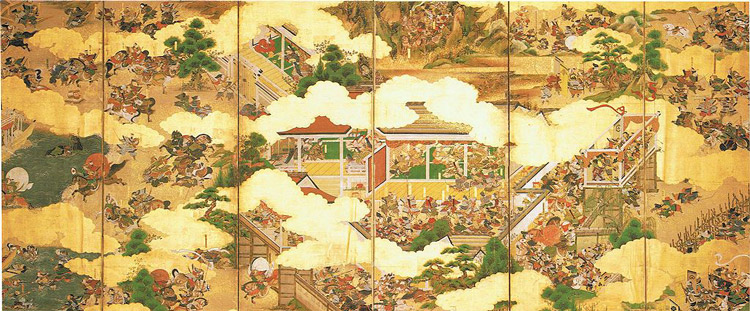From food to dance to fashion — Japan is a hallmark of culture and tradition. The Japanese have always expressed themselves in various manners, building and rebuilding art around society as they know it. This is especially true with their literature, serving not only as entertainment but also as a record of the lives led during those eras.
Today, we’ll take you on a crash course to learn more about the history of Japanese literature through the millennia. Let us know which era you think has the best works!
Earliest Traditions
As with most other cultures, the beginnings of Japanese literature can be traced back to oral traditions passed down from generation to generation. It is only through the introduction of a written language from China that these stories were recorded.

The Kojiki (Record of Ancient Matters), written in 712, is an anthology of the myths, legends, and other stories which previously only existed in the minds of the people. On the other hand, the Nihon shoki (Chronicle of Japan), written in 720, was a chronological record of the history of the small archipelago. There was also the Fudoki (Records of Wind and Earth), compiled by provincial officials beginning in 713, that detailed the history, geography, specialty products, and folklore of the many provinces of Japan.
Aside from these historical accounts, creativity was also abundant in that era. Perhaps the most brilliant literary compilation of that period was the Man’yoshu (Collection of Ten Thousand Leaves), compiled circa 759 and composed by people of all walks of life — from the simplest commoners to the mightiest emperors. From this work, a 31-syllable pattern (5-7-5-7-7) known as tanka can be noticed, similar to the more popular haiku pattern we know today.
Heian Period: 794 – 1185

Beyond its writing system, China also passed down many other things to Japan. As such, the Heian period may be seen as an emulation of Chinese culture and customs. Nobles dressed in Chinese fashion, and they pursued the arts of literature, poetry, painting, dancing, calligraphy, and more. The Imperial Court used Chinese much in the same way the Medieval European nobility used Latin — as a symbol of knowledge and, to a great extent, status. Thus, as a sign of the separation between men and women, the latter were also not allowed to speak Chinese.
Despite this, the Heian era is still widely acknowledged as the golden era of art and literature in Japan. The most notable work of this period, hailed as a masterpiece, is the Genji Monogatari by Murasaki Shikibu. It was the first novel ever written in the country, gaining recognition from even the emperor. What makes this work unique is that it was written by a woman for a female audience, meaning that it was also likely written in the Japanese language, with the Japanese phonetic alphabet kana.

Another important work from this period is the Kokin wakashu or Kokinshu (Collection of Poems from Ancient and Modern Times), written in 905. This was a waka-poetry anthology — the first-ever of its kind commissioned by the emperor. The Makura no soshi, written by Sei Shonagon in the 990s, talks about the life, love, and pastimes of the nobles in the Imperial Court.
Lastly, this era also produced the Taketori Monogatari, the story of a princess from the Moon raised by a bamboo cutter. You may be more familiar with this story as “The Tale of Princess Kaguya”, an adaptation of the tale animated by Studio Ghibli. This tale can be considered as one of the earliest prototypes of science fiction today, with illustrations of the manuscript depicting a disc-shaped object similar to today’s flying saucer.

This period is the Medieval Era of Japanese literature, strongly influenced by Zen Buddhism as well as the philosophies of the civil wars ongoing at that time. As such, much of the literature from this era shifted its focus from the nobility to priests, travelers, and ascetic poets, as well as to the perspective of the warrior class. The most prominent genre was war tales, with themes concerning life and death, redemption through killing, and the desire for a simpler life.
In this era, the grand epic Heike Monogatari was completed, detailing the rise and fall of the Taira clan as they fought against the Minamoto clan. This story is action and drama like never witnessed before in Japanese literature — rooted in Buddhist ethics, featuring moving battle scenes and sorrowful reminiscence for those who have passed.
Edo Period: 1600 – 1868

The Edo Period, also known as the Tokugawa period, was generally a time of peace and balance in Japan. After years of warring among feudal states, the stabilization of the country also resulted in rising literacy rates amongst the common people. During this time, the function of literature expanded to become a social activity.
What became a popular pastime was Renga — a literary game wherein several people recite linked verses that form a long poem. This period also brought about Matsuo Basho’s perfection of the haiku 5-7-5 format, embodying elegance, simplicity, and tranquility within the short verses.

During the Genroku Era (1688-1704), an unprecedented trend occurred. Instead of the nobility, city-dwelling artisans and merchants became the main audience and supporters of the literary arts. They wrote Joruri, a genre of storytelling involving chanted lines, and even the popular Kabuki plays, a highly stylized manner of performance.
Thus, many new genres of Japanese literature were created during the Edo period. The growing literate population, the influence of the West in certain settlements, and the importation of Chinese vernacular fiction all led to the creation of Early Modern Japanese Fiction. It is said that Ihara Saikaku’s tales on the pleasure quarters gave birth to the consciousness of novels in Japan. The Yomihon genre is commonly fantastical stories of historical romance written in prose, inspired by Chinese literature.
Other authors wrote a large variety of genres in this era, from romance to comedies to fantasy and historical fiction. Nevertheless, despite the great progress seen in the development of literature, most scholarly works continued to be published in the Chinese language system, making it inaccessible for the common folk.
Meiji Period: 1868 – 1945

The Meiji period was a time of rapid change and industrialization, as Japan reopened its doors to foreign influence. The influence of European literature was made evident in the emergence of new intellectual themes in Japanese works — Enlightenment, Realism, Classicism, Romanticism, Naturalism, Neo-romanticism, and Proletarian literature. These developments occurring in such a short period of time also encapsulate the mindset of the people during this period.
Fukuzawa Yukichi and Water Margin were among the pioneers of Enlightenment literature in Japan, influenced by the ideologies of the West as their lives began shifting around a rapidly changing country. Tsubouchi Shoyo and Futabatei Shimei brought Realism in the mid-Meiji era, but it was Ozaki Koyo, Yamada Bimyo, and Koda Rohan’s Classicism that gained popularity.
Mori Ogai leaned towards Romanticism with his anthology of translated poems and other works from the West, with works such as The Dancing Girl (1890) and Wild Geese (1911). Toson Shimazaki, who popularized the aforementioned genre, shifted to a Naturalist ideology. Neo-romanticism arose as an anti-naturalist response, led by figures such as Kafu Nagai and Hakushu Kitahara in the early 1910s.
Finally, in the latest movement in the Meiji period, Proletarian literature that hoped to empower the lower class became a movement, with works depicting the harsh struggles of workers, peasants, women, and other disadvantaged members of society.

With Japan’s defeat in World War II, much of Japanese literature began taking on a darker tone — stories of disaffection, loss of purpose, and coping with defeat were common. Much of the literature from this time depicted soldiers and civilians alike dealing with the aftermaths of a war that killed millions in the country. The Setting Sun by Osamu Dazai tells the story of a soldier returning from Manchukuo, while Shohei Ooka won an award for Fires on the Plain, the narrative of a Japanese deserter losing his mind in the Philippine jungles.
In the 1970s and 1980s, the need to raise social and political consciousness became apparent as writers began delving deeper into intellectual and moral dilemmas. Kenzaburo Oe’s A Personal Matter (1964) dives into the story of a father who has to come to terms with the mental disability of his newborn son — a topic much less explored during those days, and a work that won him a Nobel Prize for Literature.
With this, a common trend could be found written across the many genres and topics that Japanese authors cover — the emphasis on the inner world. Where plot development and action are primary in Western works, Japanese literature is much more focused on the internal narration and emotions of the characters. This led to the reaffirmation of national characteristics — a return to past values and attitudes.

In the 1980s, popular fiction, non-fiction, and children’s fiction flourished in the urban areas of Japan. Today, Japan is one of the most popular producers of fiction in the world. Manga has proven its relevance not just in Japan, but in international markets all over the globe. They tackle all sorts of topics and interests, with a hundred different subgenres catering to the tastes of every reader.
Perhaps, that is the most apt way to describe Japanese literature — ever-evolving, always hoping to cater. As modern Japan moves into a new era, they are only certain to find more ways to express themselves in the way they know best — literature.

















































